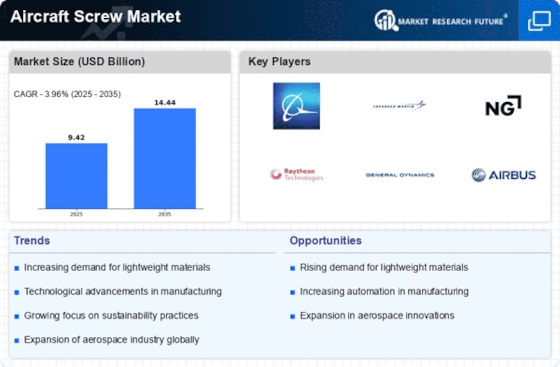Rising Aircraft Production Rates
The Aircraft Screw Market is poised for growth due to the rising production rates of commercial and military aircraft. As global air travel continues to expand, manufacturers are ramping up production to meet the increasing demand for new aircraft. This surge in aircraft production directly correlates with the need for high-quality screws and fasteners, which are critical components in aircraft assembly. Recent statistics indicate that aircraft production is expected to increase by approximately 4% annually over the next decade, driven by both new aircraft orders and the need for fleet modernization. Consequently, this trend is likely to bolster the Aircraft Screw Market, as manufacturers seek to supply the necessary components to support this growth in aircraft production.
Regulatory Compliance and Safety Standards
The Aircraft Screw Market is significantly influenced by stringent regulatory compliance and safety standards imposed by aviation authorities. These regulations necessitate the use of high-quality, reliable fasteners that can withstand extreme conditions and ensure the safety of aircraft operations. As a result, manufacturers are compelled to invest in advanced testing and quality assurance processes to meet these standards. The increasing focus on safety in aviation is likely to drive demand for specialized screws that comply with international safety regulations. Furthermore, the market is expected to see a rise in certifications for aircraft components, which could further enhance the credibility and reliability of products within the Aircraft Screw Market. This emphasis on compliance not only ensures passenger safety but also fosters consumer confidence in the aviation sector.
Technological Innovations in Manufacturing
Technological advancements in manufacturing processes are reshaping the Aircraft Screw Market. Innovations such as additive manufacturing and precision machining are enabling the production of screws with enhanced performance characteristics and reduced lead times. These technologies allow for the creation of complex geometries and customized solutions that meet specific aircraft requirements. As manufacturers adopt these advanced techniques, the efficiency of production is likely to improve, leading to cost reductions and increased competitiveness in the market. Moreover, the integration of automation and robotics in manufacturing processes is expected to enhance precision and consistency in screw production. This trend towards technological innovation is anticipated to drive growth in the Aircraft Screw Market, as companies strive to meet the demands of modern aircraft design and production.
Increasing Demand for Lightweight Materials
The Aircraft Screw Market is experiencing a notable shift towards lightweight materials, driven by the aviation sector's emphasis on fuel efficiency and performance. Manufacturers are increasingly utilizing advanced materials such as titanium and composite alloys, which not only reduce the overall weight of aircraft but also enhance durability and resistance to corrosion. This trend is reflected in the growing adoption of lightweight screws, which are essential for modern aircraft designs. According to recent data, the demand for lightweight components in the aerospace industry is projected to grow at a compound annual growth rate of approximately 5.5% over the next five years. This shift towards lightweight materials is likely to propel the Aircraft Screw Market, as manufacturers seek to meet the evolving requirements of aircraft design and performance.
Focus on Sustainability and Eco-Friendly Practices
The Aircraft Screw Market is increasingly aligning with sustainability initiatives as the aviation sector seeks to reduce its environmental impact. Manufacturers are exploring eco-friendly materials and production methods that minimize waste and energy consumption. This focus on sustainability is prompting the development of screws made from recyclable materials and the implementation of green manufacturing practices. As airlines and aircraft manufacturers prioritize sustainability in their operations, the demand for environmentally friendly components is expected to rise. This trend not only addresses regulatory pressures but also aligns with consumer preferences for sustainable practices. The Aircraft Screw Market is likely to benefit from this shift, as companies that adopt sustainable practices may gain a competitive edge in the market.

















Leave a Comment